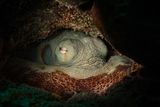Octopuses May Dream: Study Reveals Colorful Sleep Patterns

Research has unveiled intriguing insights into the sleep patterns of octopuses, suggesting that these marine creatures may experience a form of dreaming. Published in March 2023 in the journal Nature, the study reveals that when octopuses fall asleep, they do not merely rest quietly. Instead, they undergo vivid episodes characterized by rapid movements and colorful skin changes, akin to human dreaming.
Understanding Octopus Sleep Cycles
To investigate these remarkable phenomena, scientists focused on the species Octopus laqueus. They confirmed that the octopuses could indeed be classified as asleep by observing their responses to stimulation. During calm sleep phases, the animals remained motionless and unresponsive, indicating genuine sleep. Notably, this quiet sleep was punctuated by bursts of activity approximately every hour, which showcased a shift to what the researchers termed “active sleep.”
Using advanced monitoring techniques, the research team tracked the octopuses’ brain activity during both waking and sleeping states. They discovered neural activity resembling the mammalian sleep spindles, which are brainwave patterns associated with memory consolidation. Although the precise function of these spindles is still unclear in humans, they are thought to play a crucial role in memory processing. The study recorded these spindle-like waves in brain regions linked to learning and memory in octopuses, indicating a complex cognitive function.
The most striking finding occurred during the active sleep phase, when octopuses exhibited neural patterns similar to those seen when they were awake. This phenomenon indicates that octopuses may experience a sleep stage comparable to human REM sleep, according to Leenoy Meshulam, a statistical physicist at the University of Washington.
The Role of Skin Patterns in Dreaming
An additional layer of intrigue comes from the octopus’s unique ability to change its skin color and pattern. Researchers filmed these remarkable displays in ultra-high 8K resolution, allowing them to analyze individual pigmented cells responsible for these transformations. The footage revealed that during active sleep, the octopuses cycled through the same skin patterns as when they were awake, suggesting a potential connection between their dreaming state and skin color changes.
These findings lead to two possible explanations for the observed behavior. One theory posits that octopuses may be practicing camouflage techniques through muscle memory. Alternatively, it is suggested that the changes in skin patterns during sleep may indicate that octopuses are dreaming, reliving experiences such as avoiding predators or hunting prey. Sam Reiter, the senior author of the study, noted that while humans can verbally recount their dreams, octopuses may express their brain activity through visual skin patterns.
This research suggests that complex sleep, including a REM-like phase, may not be limited to mammals. The study expands our understanding of cognition in diverse species, highlighting the evolutionary significance of dream-like states in animals with distinct brain structures.
The implications of these findings are vast, encouraging further exploration into the cognitive capabilities of cephalopods and their unique adaptations. As our understanding of animal behavior evolves, the potential for discovering more about the inner lives of these fascinating creatures continues to grow.






